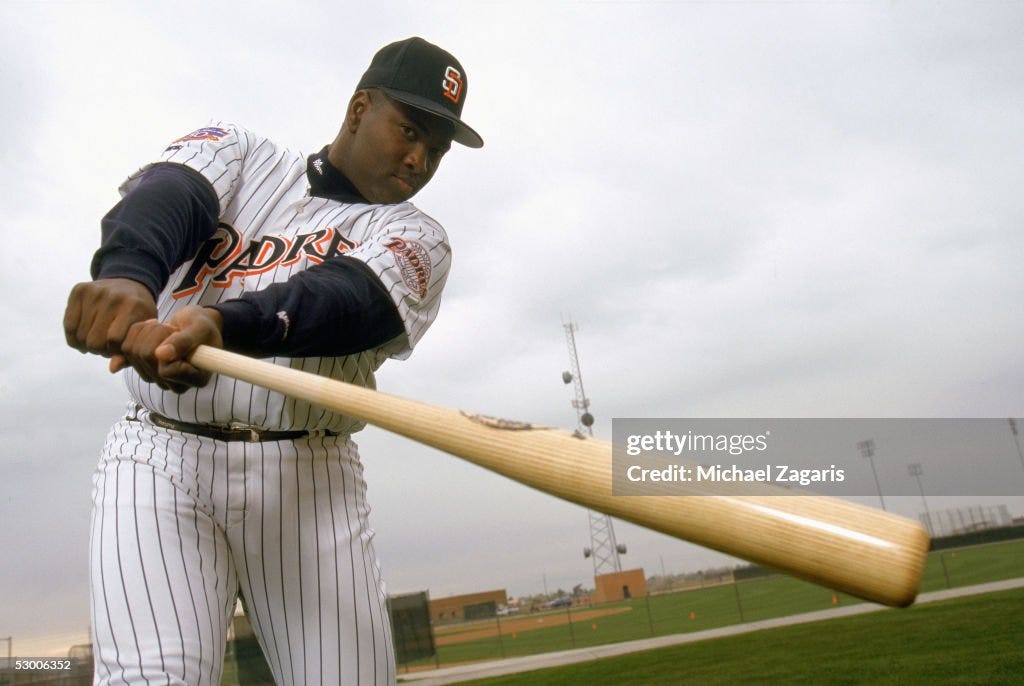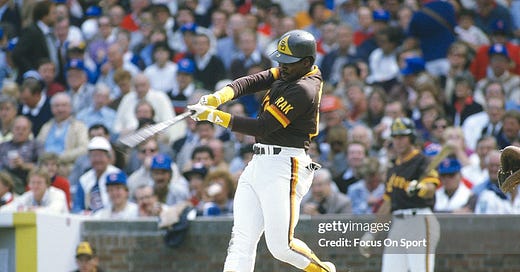
I remember a lot of talk about the impact of free agency when I was a kid. We were not that far removed from the end of the reserve clause, which happened in the mid-70’s, and the battle lines drawn during Curt Flood’s legal case and its immediate aftermath were still fresh. A decade later, we were watching the consequences of those moves play out in real-time.
I’m not going to rehash the details of that fight here, mostly because it’s unnecessary. As a fan of a small market team, I know as well as anyone that baseball has major economic issues, and MLB has rarely been proactive in addressing them. These problems pose a threat to the game’s future, and free agency and the continually rising costs associated with it are absolutely a part of their threadwork.
But free agency isn’t going anywhere, so there’s no point in arguing over it. Nor do I think it should be eliminated. In a war between billionaires and millionaires, I don’t side so much with the millionaires, as with the majority of players who make a league minimum salary. I’m all for the everymen of the league, who give everything they have to play the game we love to watch, banking as much money as they can during their usually short careers.
This doesn’t mean I’m enamored with every aspect of free agency, however. I think it’s only fair that players make as much as they can, and though my team isn’t often in contention, it’s nice to know they can strengthen their roster every offseason by spreading around a little cash. (The fact that they rarely do is another conversation entirely.) But it comes at a cost. And the biggest cost, in my opinion, is the loss of players (especially superstars) who play their entire careers with one team.
One-team players are practically extinct now, and to be fair, they were endangered by the time I came along. Some of the best players of my youth— Wade Boggs, Roger Clemens, Mark McGwire, Greg Maddux, to name a few off the top of my head— all bounced around to multiple teams. This was a marked departure from the stars of my dad’s youth, and especially my grandfather’s. But there were still a few holdouts.
George Brett was my favorite player growing up, and he spent his whole career with the Royals. I can’t even imagine him in another team’s uniform, and frankly, it makes me slightly ill to even try. But that’s a foreign concept to kids watching the game today, and I do believe the game is poorer for it. As we Royals fans nervously chew our nails, waiting to see if the team can lock down Bobby Witt Jr. with a long-term contract, we know that even if they do, it’s still extremely unlikely that he’ll finish his career in Kansas City. He may be the next Royals superstar, but he’ll never be the next George Brett. Unless the economics of the game change dramatically, there will never be another George Brett.
With that in mind, I want to spend the next few weeks highlighting some of the great one-team stars of my youth. Of course, I’ve written extensively on George Brett before, so I’m going to branch out to other teams. First up on the docket is Mr. Padre himself, Tony Gwynn.
Tony Gwynn got that moniker because he spent his entire twenty-year career in San Diego, and no athlete has ever been more closely associated with the city. He played college ball at San Diego State, but he was actually a multi-sport star for the Aztecs. In addition to baseball, Gwynn played basketball in college, and was an all-WAC athlete in both sports. And if you need further proof that he was destined to be in San Diego, he was even drafted by the then-San Diego Clippers of the NBA.
Gwynn took a lot of flak for his weight throughout his career, and there’s no denying that he didn’t fit the stereotypical profile of an elite athlete. He had a bit of a gut, and when he opened his mouth to talk, usually with a sizeable wad of tobacco tucked into his cheek, he certainly didn’t sound like a California guy. With a twang to his voice, he always sounded to me like he would have been right at home in rural Kansas, hanging out with my dad and his farmer friends. But none of them could run point for a Division One basketball team or hit .300 with their eyes closed. Make no mistake about it — Tony Gwynn was a world class athlete.
And with a baseball bat in his hands, he was something out of this world. Every now and then, you hear someone argue that Gwynn was overrated. They claim he didn’t hit for enough power, and that he was more concerned with his batting average than doing what he could to help the team win. These criticisms aren’t just from modern-day blowhards on Twitter either. Gwynn heard this from teammates like Jack Clark and Garry Templeton too. At one point, they even hung a Gwynn figure in effigy in the dugout.
Here’s the thing though. Clark and Templeton were kind of idiots. (Did evoking the racist imagery of lynching over a petty baseball dispute not give it away?) There’s a reason the Padres let those guys go and hung onto Gwynn. Sure, Gwynn was never a slugger. Part of that was by design. In the early to mid-80’s, Gwynn tailored his game to Manager Jack McKeon’s style, which called for him to focus on contact over power. And part of it was simply Gwynn’s makeup. But hitting homeruns was about the only thing Gwynn did not excel at in the batter’s box.
Check out his career numbers:
He won eight league batting titles (second most, behind Ty Cobb), including three in a row from 1987-89, becoming the first player to do that since Stan Musial in 1950-52. The man made fifteen All-Star appearances, won seven Silver Slugger awards, and for those of you thinking he was a one-dimensional player, he also picked up five Gold Gloves. True, Gold Gloves aren’t necessarily the best indicator of great defense (ironically enough), but he was a much better defender in RF than is generally assumed, even if he didn’t start out that way. His defensive improvement is a testament to the work ethic he brought to the game.
Gwynn never won a ring. A World Series trophy continues to elude the Padres, but he was present for both the team’s Fall Classic appearances in 1984 and 1998. Unfortunately for him, they came up short both times, first against the Tigers and later against the Yankees. I would add that the 1998 Yankees might be the single greatest team in baseball history, so there’s no shame in losing to them. And in any case, little blame can be placed on Gwynn. His career postseason numbers, over three appearance in 1984, 1996, and 1998, are: .306/.339/.398, 1 HR, 11 RBI, 33 H, 7 doubles, and a .737 OPS.
It was practically impossible for him to hit below .300. Pete Rose, the most prolific hitter in MLB history, saw this right away. He was on hand for Gwynn’s first career hit against the Phillies in 1982, and after congratulating him, warned him not to pass his hit total in one night. Perhaps an even better testimonial comes from the best pitcher I’ve ever seen, Greg Maddux.
Maddux hated facing Gwynn. Most hardcore baseball fans are aware of this fact, but it’s still worth mentioning. Gwynn faced the Hall-of-Fame Braves trio of Maddux, Tom Glavine, and John Smoltz a combined 323 times in his career, and only struck out three times. That’s insane. As Maddux put it, “If a pitcher can change speeds, every hitter is helpless, limited by human vision. Except for that fucking Tony Gwynn.”

Gwynn’s only Achilles’ heel was his health, so it is perhaps ironic that his greatest season was cut short not by an injury, but by the Strike that shut down all of baseball in 1994. Check out his stats for that doomed season:
110 G, .394/.454/.459, 12 HR, 64 RBI, 165 H, 35 doubles, 1.022 OPS, 169 OPS+
It’s worth noting that even in the strike-shortened season, he still missed 34 games, but he ended up three hits shy of becoming the first player to bat .400 since Ted Williams did it in 1941. Would he have kept up that pace over an entire season if the Strike had not halted everything? Hard to say, but there’s no reason to think he wouldn’t have made a run at it. As it is, Gwynn’s 1994 season is the closest attempt at .400 and best season at the plate since George Brett came up five hits short of .400 in 1980.
Tony Gwynn is worthy company for Brett. In 1999, he recorded his 3,000th hit, becoming just the eleventh player to reach the milestone for a single team, and the first to do it since Brett and Robin Yount accomplished the feat in 1992. His .338 career batting average is the highest of any player who began his career after World War II.
In many ways, however, Gwynn was a true throwback. He never struck out more than forty times in a single season. He had eight seasons where he struck out less than twenty times, and he only struck out three times in a game once. These are inconceivable stats in the modern game.
Perhaps even more striking, he turned down bigger money on several occasions to stay in San Diego. It seems strange, given their recent history of spending big money for baseball mercenaries, but the Padres were generally cheapskates in Gwynn’s day. He never seriously considered leaving though. Maybe the idea of San Diego without Tony Gwynn was just as unpalatable to him as it was to the rest of us.
Sadly, Tony Gwynn died in 2014 at the age of 54. He succumbed to cancer, probably caused by his trademark chewing tobacco habit. But he’s still part of the fabric of Padres baseball. If you have any doubts, just check his HOF plaque in Cooperstown, his highlight reels on YouTube, or the statue that stands at Petco Park.
Because not even death can separate Tony Gwynn and San Diego.
Quick note for all my readers, but especially those of you who are Royals fans. Before you close out this article, I invite you to read a piece I wrote about Kevin Seitzer replacing George Brett at Kings of Kauffman. You can find it by clicking here.
Thank you for reading Powder Blue Nostalgia. What are your memories of Tony Gwynn? Do you have a favorite one-team player? We’ll have another one next week. And hey, Royals fans, make sure you check out some more of my work at Kings of Kauffman!




Tony was a superstar no doubt. A pure hitter the likes we see come along only once in a generation. Sad he died so young!